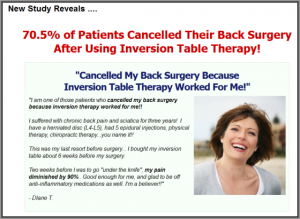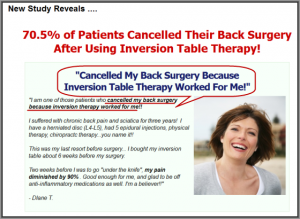“Creating Perfect Landing Page Testimonials Was Incredibly Easy Using This Trick”
Testimonials increase sales. But don’t take my word for it:
 Chris had big results even with “sober” testimonials
Chris had big results even with “sober” testimonials“Testimonials increased sales by 34%”
It’s commonly thought that social proof can help in the sales process, so we wanted to leave nothing to chance and test it. Testimonials increased sales by 34%. The testimonials we used are very ‘sober’ (compared with the overly enthusiastic ones you so often see in marketing literature). The test results were surprising.
– Chris Mukta, founder of WikiJob (source)
So did it work? Did the testimonial convince you? 🙂
Unfortunately, most landing pages have terrible testimonials. It’s just too easy to make common mistakes.
Mess it up, and your split tests will make you think that testimonials don’t work at all.
The Two Reasons Most Testimonials Don’t Work
The first and biggest mistake is using testimonials to support a vague claim that your product is awesome.
Think about it. If a company said its product was “just amazing”, you wouldn’t believe them at all.
And if the company then trotted out a testimonial that repeated the same thing, you wouldn’t believe that either. Nobody believes a “this product is awesome” testimonial anymore.
The second most common mistake is stuffing a bunch of unrelated testimonials that all corroborate different claims into what I call a “testimonials ghetto”.
Imagine if you were buying something and three different salespeople started talking to you at once. That’s how prospects react when they see a block that contains quotes like “Great service!”, “I would use them again” and “Sells quality products” all listed one on top of each other.
So what do you do instead?
How To Create Specific Testimonials That Actually Work
Here’s the simple rule: Testimonials only increase conversions when they corroborate a specific benefit that the customer values.
I call these Specific Testimonials.
Take a look at the Specific Testimonial at the top of this page. I stated a specific benefit that testimonials increased sales. This is definitely a specific benefit that people value, because every landing page owner wants to increase sales.
Next, I showed a quote from an actual entrepreneur that increased sales by making a testimonial more prominent on his landing page. This corroborates my specific benefit.
This landing page states the powerful benefit that “70.5% of Patients Cancelled Their Back Surgery After Using Inversion Table Therapy!”
This is a great benefit, because back surgery is something that any back pain sufferer fears.
Next, the landing page shows a Specific Testimonial that corroborates that specific benefit. “Diane T.” tell the story of how she “cancelled my back surgery because inversion table therapy worked for me!”
That is a spot-on testimonial that corroborates a powerful benefit.
“Testimonials only increase conversions when they corroborate a specific benefit that customers value.”
The 5-Step Formula For Creating Specific Testimonials
As long as you avoid vague “this product is awesome” testimonials, you’re already ahead of the game.
But you can substantially boost conversion rates if you follow this simple 5-step process to creating Specific Testimonials:
Step 1: Set the stage by stating a specific benefit that people value
You can list lots of benefits for your product or service.
Your landing page can showcase multiple testimonials.
But each testimonial needs to corroborate a single benefit.
So the first step for a Specific Testimonial is to figure out what benefit you want to corroborate. You can pick any benefit, as long your prospects value this benefit.
If you’re selling orthopedic shoes, your prospects won’t value a benefit like “shave 10 seconds off of your mile time.” But they will value a benefit like “our shoes eliminate foot pain in 75% of our customers.” So go with that.
Step 2: Find or solicit a testimonial that corroborates that specific benefit
After picking a specific benefit, find or solicit a testimonial that has these three qualities:
- It corroborates a specific benefit with a compelling story
- It has specific details that add credibility
- It’s signed by an actual person (or at least first name and last initial, preferably with city)
Be careful not to fall in love with a great quote that doesn’t relates to your specific benefit.
For instance, there are lots of testimonials on that inversion table landing page that support other benefits. One testimonial explains how the table “got rid of the pain.” Another says the table let them “walk dance, garden and shower.”
These testimonials are great, but they don’t relate to the specific benefit about cancelling back surgery. That’s why the landing page author didn’t use them there.
If you can’t find a great quote in your archives, contact some satisfied customers and ask them if they’ve experienced a specific benefit. If your product delivers a particular benefit, it should be easy to get a good benefit-specific quote from a satisfied customer.
Finally, resist the temptation to put words in the customer’s mouth. A testimonial that sounds coached has no credibility.
Step 3: Add quotes around your pull quote and style it like a headline
Writing your own testimonial headline spoils the beauty of the customer explaining the benefit of the product for you. It’s a lot more credible when the customer explains the benefit for you.That’s why using a quote pulled from the testimonial as a headline works so well.Adding quotes around your pull quote makes it clear that you’re quoting the testimonial, and not just making yet another brash claim yourself.
You should also style the pull quote like a headline, to draw attention to the testimonial.
Step 4: Add a Picture To Your Specific Testimonial
Adding a picture alongside a testimonial attracts attention to the testimonial. The picture also makes the testimonial text take up less width, which encourages readers to that might too intimidated to read a wide block of text.
Ideally, the picture will demonstrate the benefit of the product. That inversion table landing page used a picture of a happy woman to illustrate how happy the woman is to have avoided back surgery.
It so happens that we know exactly what kind of image they were looking for because TinEye tells us that the original photo comes from iStockPhoto with the title “Happy Woman”.
For this testimonial, I would try testing an actual picture of the woman who gave the testimonial (if that’s available). It may not look as good, but this picture looks so good that it looks like a stock photo.
Step 5: Add a caption to your picture
Readers often start by skimming headlines and captions before reading body copy. So writing a good testimonial caption can be the first impression the reader gets of your testimonial.
Master copywriter Joe Sugarman says that “all the elements in an advertisement are primarily designed to do one thing and one thing only: get you to read the first sentence of the copy.”
So the caption on a testimonial picture should increase readers’ curiosity to read the testimonial. You can increase curiosity by writing a caption that leaves an “information gap” between what people know and what people want to know. In other words, create drama in the caption by leaving something out.
The inversion table testimonial doesn’t have a picture caption, but a caption like this might make a curious reader read the testimonial copy: “Diane T. bought her inversion table just six weeks before her scheduled back surgery”. That caption creates an information gap by leaving out the fact that Diane then cancelled her back surgery.
At the top of this blog post, you can see another curiosity-inducing caption: Chris had big results even with “sober” testimonials. Again, we left out the specifics of his results to create an information gap.
Here’s What To Do Next…
- Follow the 5-step process above to create a benefit-specific testimonial. Then create a split test and see if the testimonial improves your conversion rate… Try testing the testimonial either in the main flow of your page, or in a sidebar to the right of your body copy where you explain the specific benefit your testimonial corroborates. Whatever your results, I’d appreciate it if you let me know how this strategy worked for you!
- If you found this useful, please share it with your friends. 🙂
- Let me know what you think in the comments!

